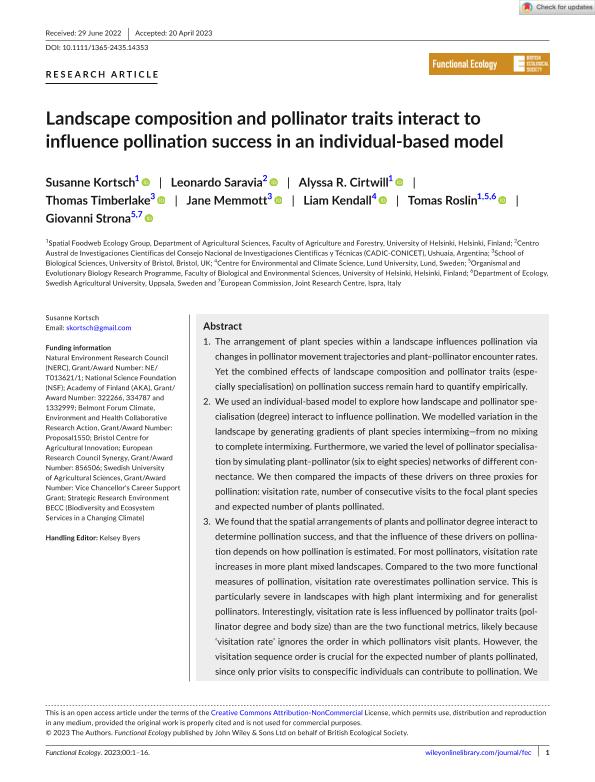Mostrar el registro sencillo del ítem
dc.contributor.author
Kortsch, Susanne
dc.contributor.author
Saravia, Leonardo Ariel

dc.contributor.author
Cirtwill, Alyssa R.
dc.contributor.author
Timberlake, Thomas
dc.contributor.author
Memmott, Jane
dc.contributor.author
Kendall, Liam
dc.contributor.author
Roslin, Tomas
dc.contributor.author
Strona, Giovanni
dc.date.available
2024-01-16T15:35:21Z
dc.date.issued
2023-07
dc.identifier.citation
Kortsch, Susanne; Saravia, Leonardo Ariel; Cirtwill, Alyssa R.; Timberlake, Thomas; Memmott, Jane; et al.; Landscape composition and pollinator traits interact to influence pollination success in an individual-based model; Wiley Blackwell Publishing, Inc; Functional Ecology; 37; 7; 7-2023; 2056-2071
dc.identifier.issn
0269-8463
dc.identifier.uri
http://hdl.handle.net/11336/223820
dc.description.abstract
The arrangement of plant species within a landscape influences pollination via changes in pollinator movement trajectories and plant–pollinator encounter rates. Yet the combined effects of landscape composition and pollinator traits (especially specialisation) on pollination success remain hard to quantify empirically. We used an individual-based model to explore how landscape and pollinator specialisation (degree) interact to influence pollination. We modelled variation in the landscape by generating gradients of plant species intermixing—from no mixing to complete intermixing. Furthermore, we varied the level of pollinator specialisation by simulating plant–pollinator (six to eight species) networks of different connectance. We then compared the impacts of these drivers on three proxies for pollination: visitation rate, number of consecutive visits to the focal plant species and expected number of plants pollinated. We found that the spatial arrangements of plants and pollinator degree interact to determine pollination success, and that the influence of these drivers on pollination depends on how pollination is estimated. For most pollinators, visitation rate increases in more plant mixed landscapes. Compared to the two more functional measures of pollination, visitation rate overestimates pollination service. This is particularly severe in landscapes with high plant intermixing and for generalist pollinators. Interestingly, visitation rate is less influenced by pollinator traits (pollinator degree and body size) than are the two functional metrics, likely because ‘visitation rate’ ignores the order in which pollinators visit plants. However, the visitation sequence order is crucial for the expected number of plants pollinated, since only prior visits to conspecific individuals can contribute to pollination. We show here that this order strongly depends on the spatial arrangements of plants, on pollinator traits and on the interaction between them. Taken together, our findings suggest that visitation rate, the most commonly used proxy for pollination in network studies, should be complemented with more functional metrics which reflect the frequency with which individual pollinators revisit the same plant species. Our findings also suggest that measures of landscape structure such as plant intermixing and density—in combination with pollinators' level of specialism—can improve estimates of the probability of pollination. Read the free Plain Language Summary for this article on the Journal blog.
dc.format
application/pdf
dc.language.iso
eng
dc.publisher
Wiley Blackwell Publishing, Inc

dc.rights
info:eu-repo/semantics/openAccess
dc.rights.uri
https://creativecommons.org/licenses/by-nc/2.5/ar/
dc.subject
AGENT-BASED MODEL
dc.subject
HABITAT HETEROGENEITY
dc.subject
MOVEMENT ECOLOGY
dc.subject
NETLOGO
dc.subject
PATCH SIZE
dc.subject
VISITATION RATE
dc.subject.classification
Ecología

dc.subject.classification
Ciencias Biológicas

dc.subject.classification
CIENCIAS NATURALES Y EXACTAS

dc.title
Landscape composition and pollinator traits interact to influence pollination success in an individual-based model
dc.type
info:eu-repo/semantics/article
dc.type
info:ar-repo/semantics/artículo
dc.type
info:eu-repo/semantics/publishedVersion
dc.date.updated
2024-01-11T15:33:52Z
dc.journal.volume
37
dc.journal.number
7
dc.journal.pagination
2056-2071
dc.journal.pais
Reino Unido

dc.journal.ciudad
Londres
dc.description.fil
Fil: Kortsch, Susanne. University of Helsinki; Finlandia
dc.description.fil
Fil: Saravia, Leonardo Ariel. Consejo Nacional de Investigaciones Científicas y Técnicas. Centro Austral de Investigaciones Científicas; Argentina
dc.description.fil
Fil: Cirtwill, Alyssa R.. University of Helsinki; Finlandia
dc.description.fil
Fil: Timberlake, Thomas. University of Bristol; Reino Unido
dc.description.fil
Fil: Memmott, Jane. University of Bristol; Reino Unido
dc.description.fil
Fil: Kendall, Liam. Lund University; Suecia
dc.description.fil
Fil: Roslin, Tomas. University of Helsinki; Finlandia. Swedish Agricultural University; Suecia
dc.description.fil
Fil: Strona, Giovanni. Joint Research Centre; Italia. University of Helsinki; Finlandia
dc.journal.title
Functional Ecology

dc.relation.alternativeid
info:eu-repo/semantics/altIdentifier/url/https://onlinelibrary.wiley.com/doi/abs/10.1111/1365-2435.14353
dc.relation.alternativeid
info:eu-repo/semantics/altIdentifier/doi/http://dx.doi.org/10.1111/1365-2435.14353
Archivos asociados
